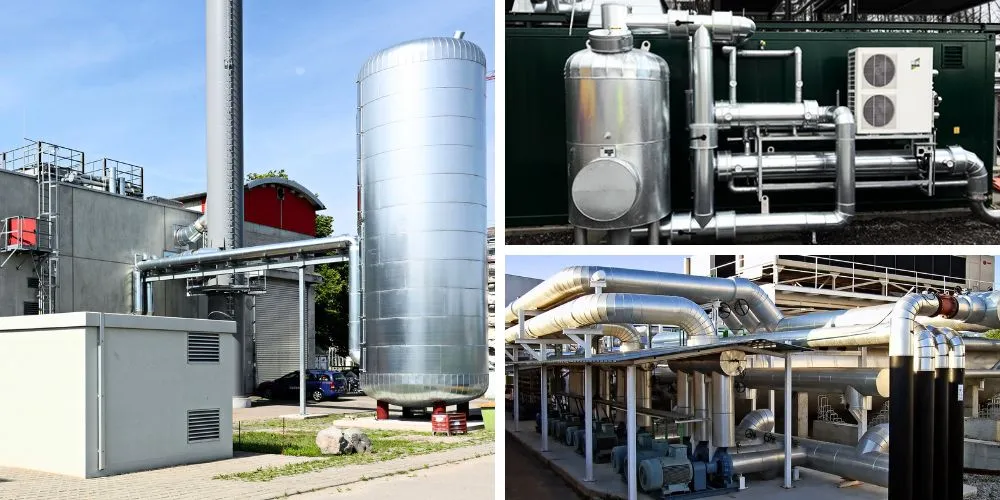Combined Heat and Power (CHP), or cogeneration, represents a groundbreaking energy production and utilization approach that is gaining increasing recognition and adoption. This comprehensive exploration delves into CHP, revealing its profound significance, underlying principles, diverse applications, and potential to revolutionize the energy sector by fostering sustainability and efficiency.
The Significance of Combined Heat and Power
Combined heat and power represent a critical departure from traditional energy generation methods, offering various compelling benefits. These advantages encompass heightened energy efficiency, reduced environmental impact, cost-effectiveness, and enhanced grid resilience.
Energy Efficiency
At its core is CHP’s exceptional energy efficiency. Unlike conventional power generation approaches, which squander a considerable amount of heat energy as a byproduct, CHP maximizes efficiency by concurrently generating electricity and capturing and utilizing the otherwise wasted heat. This dual-purpose approach significantly boosts the overall energy conversion efficiency, making it a standout solution for sustainable energy production.
Emissions Reduction
Combined heat and power systems inherently contribute to emissions reduction, producing fewer greenhouse gases per unit of energy generated compared to traditional power plants. By optimizing fuel use and accommodating low-carbon or renewable fuels, CHP significantly reduces its environmental footprint, thus substantially contributing to mitigating the environmental impact of energy generation.
Cost Savings
One of the most compelling aspects of CHP is its potential for cost savings. Businesses and industries that implement CHP systems can significantly lower their energy expenses. This enhanced cost-effectiveness translates into improved competitiveness and a quicker return on investment than traditional energy generation methods.
Grid Resilience
CHP systems bolster grid resilience by offering decentralized sources of power generation. During grid outages or disruptions, CHP systems can seamlessly provide reliable backup power, ensuring the uninterrupted operation of critical facilities such as hospitals and data centers. This increased grid stability reduces the risk of widespread blackouts and enhances overall energy security.
Principles of Combined Heat and Power
Several fundamental principles underpin the operation and efficiency of Combined heat and power systems, providing a solid foundation for their widespread adoption.
Simultaneous Generation
The hallmark of CHP is its simultaneous generation of electricity and useful heat from a single energy source. This approach maximizes energy efficiency by minimizing the dissipation of heat energy as waste.
Fuel Flexibility
CHP systems exhibit remarkable versatility in terms of fuel sources. They can effectively operate with various fuels, including natural gas, biomass, coal, and waste heat from industrial processes. This flexibility enables CHP to adapt to local fuel availability and sustainability objectives.
Distributed Generation
CHP systems can be distributed across diverse locations, including industrial facilities, commercial buildings, and campuses. This decentralized approach minimizes transmission and distribution losses and enhances energy resilience by reducing dependence on centralized energy sources.
Technologies in Combined Heat and Power
CHP encompasses diverse technologies, each tailored to specific applications and fuel sources.
Gas Turbines
Gas turbines are commonly utilized in CHP systems, particularly in industrial settings. These turbines efficiently convert natural gas or other fuels into electricity and heat. Gas turbines are renowned for their high energy conversion efficiency and rapid response times.
Reciprocating Engines
Reciprocating engines, encompassing internal combustion engines and Stirling engines, are widely employed in CHP systems. They are highly efficient and suitable for various fuel types, making them adaptable to various applications.
Steam Turbines
Combined heat and power systems involving high-pressure steam employ steam turbines, which are often encountered in industrial processes. These turbines efficiently generate electricity by expanding steam and simultaneously provide process heat.
Micro-CHP Systems
Micro-CHP systems have gained traction in residential and small-scale applications. These compact systems can be installed in homes, offering homeowners electricity and space heating, resulting in energy savings and reduced environmental impact.
Applications of Combined Heat and Power
CHP finds diverse applications across sectors, offering tailored solutions to meet energy needs efficiently.
Industrial Facilities
CHP is widely adopted in industrial facilities, where it optimizes energy utilization, reduces operational costs, and enhances overall efficiency. These systems often tap into waste heat from industrial processes to generate electricity while providing essential heating and cooling.
Commercial Buildings
Commercial buildings, encompassing hotels, hospitals, and office complexes, derive substantial benefits from CHP systems. These systems improve energy efficiency, reduce utility bills, and ensure a reliable power supply, particularly in critical applications.
District Heating
CHP plays a pivotal role in district heating systems, which generate both electricity and heat for multiple buildings and residential areas. These systems are prevalent in European cities and significantly contribute to energy efficiency and emissions reduction.
Residential Applications
Micro-CHP systems are gaining momentum in residential applications. They provide homeowners with a cost-effective and sustainable means of generating electricity and heat while diminishing their carbon footprint.
Challenges and Considerations
While promising, the adoption of CHP comes with challenges and considerations that necessitate careful evaluation.
Initial Capital Costs
CHP systems often require a substantial initial capital investment. Businesses and industries must conduct thorough cost-benefit analyses to assess the long-term advantages and justify these upfront costs.
Fuel Availability and Infrastructure
The availability of suitable fuels, such as natural gas or biomass, is a pivotal consideration for successful CHP implementation. Additionally, existing infrastructure may need modification to accommodate CHP systems, necessitating careful planning and investment.
Regulatory and Policy Support
Effective regulatory frameworks and policies are essential to incentivize the widespread adoption of CHP. These frameworks should encourage energy efficiency, emissions reduction, and seamless integration into the energy landscape. Moreover, they should create a conducive environment for innovation and investment in CHP technologies.
The Future of Combined Heat and Power
The future of CHP is characterized by ongoing advancements, increased integration with renewable energy sources, and a growing emphasis on sustainability.
Advanced CHP Technologies
Ongoing research and development efforts are focused on enhancing the efficiency and flexibility of CHP technologies. Innovations may encompass improved combustion processes, advanced materials, and more efficient heat recovery systems.
Integration with Renewables
Combined heat and power systems will increasingly integrate with renewable energy sources such as solar and wind to reduce emissions and enhance sustainability. Hybrid systems that combine CHP with renewables offer a balanced approach to energy generation.
Energy Storage
Integrating energy storage technologies with CHP systems will enable better management of energy output and increased grid flexibility. Storage solutions can store excess electricity during peak demand or when CHP systems are not operating, ensuring a continuous and reliable energy supply.
Conclusion
Combined Heat and Power is a pioneering and transformative approach to energy generation and utilization, offering many advantages spanning efficiency, sustainability, and cost-effectiveness. CHP emerges as a beacon of progress as the world progresses towards a more sustainable and efficient energy future. Challenges related to initial capital costs, fuel availability, and regulatory support must be addressed to unlock its full potential. It envisions a future where industries and communities harness energy with unprecedented efficiency, minimizing waste and environmental impact. CHP is a pathway to a more sustainable, resilient, and equitable energy landscape, propelling us toward a future where energy efficiency and sustainability are paramount.









